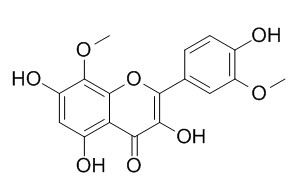Limocitrin
Limocitrin is a constituent of citrus fruit peels, belongs to the family of Flavonols.
Inquire / Order:
manager@chemfaces.com
Technical Inquiries:
service@chemfaces.com
Tel:
+86-27-84237783
Fax:
+86-27-84254680
Address:
1 Building, No. 83, CheCheng Rd., Wuhan Economic and Technological Development Zone, Wuhan, Hubei 430056, PRC
Providing storage is as stated on the product vial and the vial is kept tightly sealed, the product can be stored for up to
24 months(2-8C).
Wherever possible, you should prepare and use solutions on the same day. However, if you need to make up stock solutions in advance, we recommend that you store the solution as aliquots in tightly sealed vials at -20C. Generally, these will be useable for up to two weeks. Before use, and prior to opening the vial we recommend that you allow your product to equilibrate to room temperature for at least 1 hour.
Need more advice on solubility, usage and handling? Please email to: service@chemfaces.com
The packaging of the product may have turned upside down during transportation, resulting in the natural compounds adhering to the neck or cap of the vial. take the vial out of its packaging and gently shake to let the compounds fall to the bottom of the vial. for liquid products, centrifuge at 200-500 RPM to gather the liquid at the bottom of the vial. try to avoid loss or contamination during handling.
PLoS One.2017, 12(3):e0173585
Int J Mol Sci.2018, 19(9):E2601
Plant Physiol Biochem.2019, 144:355-364
Anal Bioanal Chem.2016, 408(1):177-90.
Foods.2023, 12(7):1355.
Mol Cancer Ther.2024, 1535-7163.
Mol Med Rep.2024, 29(2):26.
Phytomedicine.2019, 55:229-237
Plants (Basel).2023, 12(5):1120.
Front Pharmacol.2022, 13:870553.
Related and Featured Products
J Agric Food Chem. 2004 Dec 15;52(25):7586-92.
Fractionation of orange peel phenols in ultrafiltered molasses and mass balance studies of their antioxidant levels.[Pubmed:
15675808]
Orange peel molasses, a byproduct of juice production, contains high concentrations of phenols, including numerous flavanone and flavone glycosides, polymethoxylated flavones, hydroxycinnamates, and other miscellaneous phenolic glycosides and amines.
METHODS AND RESULTS:
Extensive fractionation of these phenols was achieved by adsorption, ion exchange, and size exclusion chromatography. Size exclusion chromatography effectively separated the different classes of flavonoids in ultrafiltered molasses, including the polymethoxylated flavones, flavanone-O-trisaccharides, flavanone- and flavone-O-disaccharides, and, finally, flavone-C-glycosides. Mass spectral analysis of the early-eluting flavonoid fractions off the size exclusion column revealed a broad collection of minor-occurring flavone glycosides, which included, in part, glycosides of Limocitrin, limocitrol, and chrysoeriol. Most hydroxycinnamates in the molasses were recovered by ion exchange chromatography, which also facilitated the recovery of fractions containing many other miscellaneous phenols. Total antioxidant levels and total phenolic contents were measured for the separate categories of phenols in the molasses.
CONCLUSIONS:
Inhibition of the superoxide anion reduction of nitroblue tetrazolium showed that a significant amount of the total antioxidant activity in orange peel molasses was attributable to minor-occurring flavones.
The miscellaneous phenolic-containing fractions, in which a large portion of the total phenolic content in molasses occurred, also constituted a major portion of the total antioxidants in ultrafiltered molasses.
J Sep Sci. 2012 Sep;35(17):2174-83.
New validated high-performance liquid chromatographic method for simultaneous analysis of ten flavonoid aglycones in plant extracts using a C18 fused-core column and acetonitrile-tetrahydrofuran gradient.[Pubmed:
22807401]
An HPLC method of high resolution has been developed and validated for the simultaneous determination of ten prominent flavonoid aglycones in plant materials using a fused-core C18-silica column (Ascentis® Express, 4.6 mm × 150 mm, 2.7 μm).
METHODS AND RESULTS:
The separation was accomplished with an acetonitrile-tetrahydrofuran gradient elution at a flow rate of 1 mL/min and temperature of 30°C. UV spectrophotometric detection was employed at 370 nm for flavonols (quercetin [QU], myricetin [MY], isorhamnetin [IS], kaempferol [KA], sexangularetin [SX], and Limocitrin [LM]) and 340 nm for flavones (apigenin [AP], acacetin [AC], chrysoeriol [CH], and luteolin [LU]).
The high resolution of critical pairs QU/LU (10.50), QU/CH (3.40), AP/CH (2.51), SX/Limocitrin (2.30), and IS/KA (2.70) was achieved within 30.3 min.



